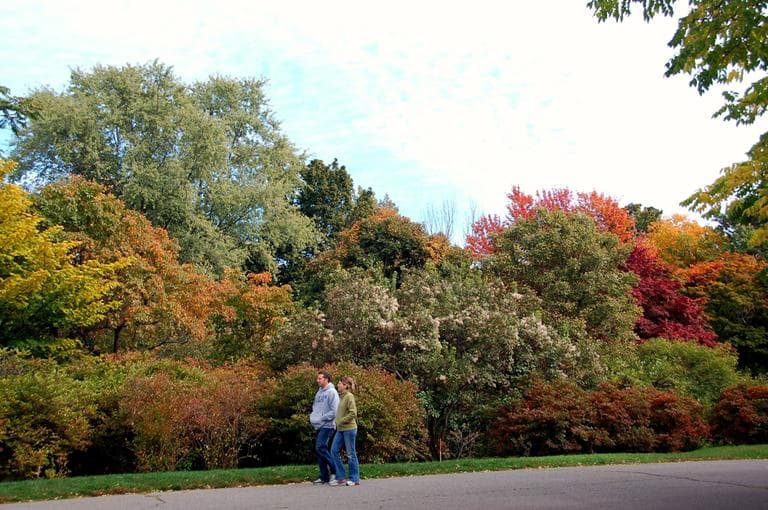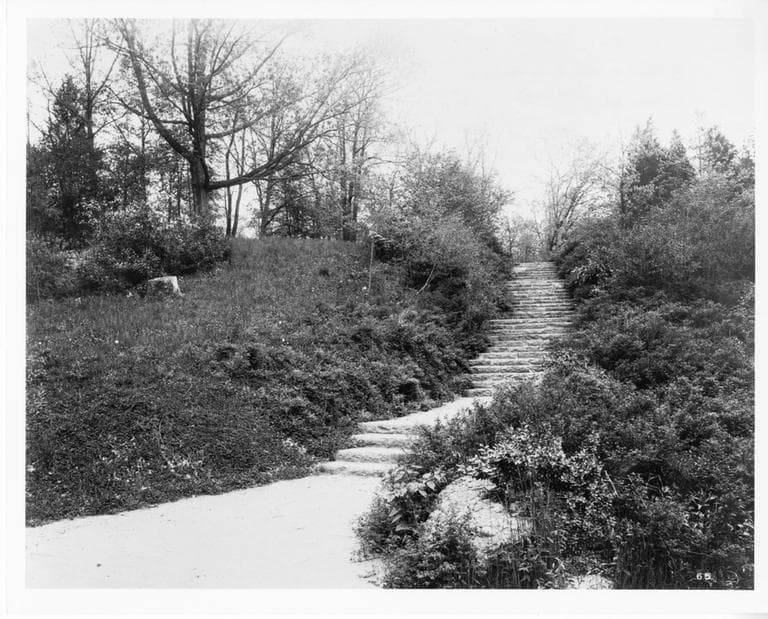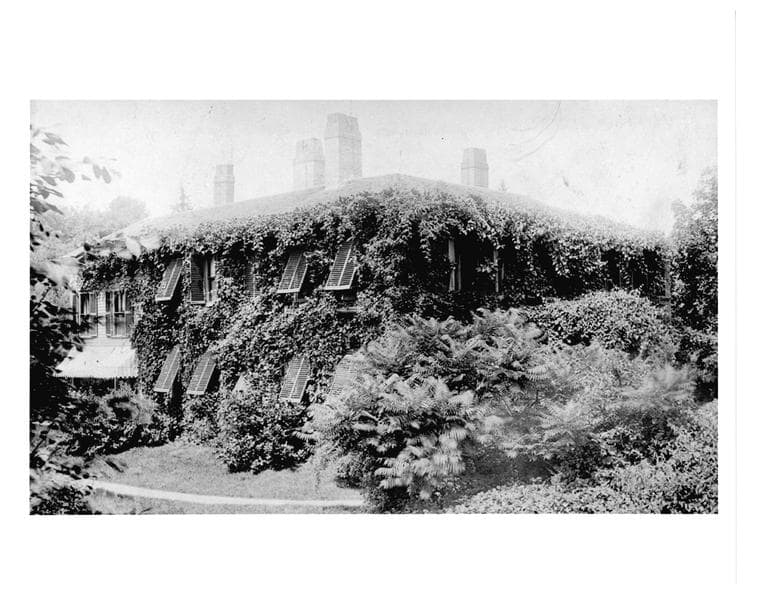Advertisement
Boston's Parks Keep Frederick Law Olmsted's Legacy
Resume
The Back Bay Fens, Franklin Park, the Emerald Necklace. Jewels of outdoor Boston, and all creations of legendary landscape architect Frederick Law Olmsted.
Even though he died in 1903, you're probably familiar with Olmsted's work. After all, Olmsted designed New York’s Central Park. But, according to Justin Martin, author of "Genius of Place: The Life Of Frederick Law Olmsted," Olmsted may "be the most important American historical figure that the average person knows least about."
“In his young life, he was very scattershot,” Martin said. “But in a way, it was almost as if he was apprenticing for once he really had the opportunity to apply himself.”
Scattershot indeed. Before taking on Central Park, he was a farmer, the executive secretary of the U.S. Sanitary Commission during the Civil War, a book author and a land surveyor. He was also an accomplished journalist and co-founder of "The Nation."
But more than anything, he was an environmentalist, dedicated to creating a natural aesthetic in his parks.
Ironically, his visions were often achieved through major interventionist means like gunpowder blasting and dredging.
He created “very natural looking landscapes, such as the Back Bay Fens in Boston, which appears a natural landscape, but was one that required all kinds of engineering," Martin said.

Finding himself an out of work journalist during a 19th-century financial crisis called the Panic of 1857, Olmsted accepted a modest job clearing a piece of land in the middle of New York. It was called Central Park.
“He was clearing the land, he was knocking down shanties and draining swamps to prepare for someone else's design,” Martin said. “Then, through a great series of coincidences and behind-the-scenes machinations, Olmsted got the opportunity to come up with a design to replace that original design."
One of the world’s most famous urban landscapes, Central Park launched Olmsted’s urban design career.
In opposition to the grand gardens of Europe, which featured manicured grasses, intense floral arrangements and grand sculptures, Olmsted let nature speak for itself. He transported people away from the stone and brick of their everyday lives.
“Nature belongs to everyone and (in Olmsted’s parks) there would not be any grand fountains and archways to remind people of their shortcomings in life," Martin said.
Ever the naturalist, Olmsted also helped preserve other natural landscapes, like Niagara Falls. For Olmsted, guaranteeing open spaces for future generations wasn't just about sustaining the beauty of mother nature.
“All of his park creations would be a place where people could meet and mingle," Martin said. "People from all different backgrounds, that was really what his designs were intended to do."
Guest:
- Justin Martin, author, "Genius of Place: The Life Of Frederick Law Olmsted"
Excerpt: Genius of Place: The Life Of Frederick Law Olmsted (PDF)
Introduction
Why Olmsted Matters
On March 25, 1893, a gala dinner was held in honor of Daniel Burnham, driving force behind the Columbian Exposition, a World’s Fair about to open in Chicago. Various artists and architects who had worked on the project gathered for this lavish event.
But when Burnham took the stage to be feted, he chose to deflect credit away from himself and onto someone else instead. “Each of you knows the name and genius of him who stands first in the heart and confidence of American artists, the creator of your own parks and many other city parks,” said Burnham. “He it is who has been our best adviser and our constant mentor. In the highest sense he is the planner of the Exposition—Frederick Law Olmsted.” Burnham paused to let that sink in. Then he added: “An artist, he paints with lakes and wooded slopes; with lawns and banks and forest-covered hills; with mountain sides and ocean views. He should stand where I do tonight, not for the deeds of later years alone, but for what his brain has wrought and his pen has taught for half a century.” A collective roar went up among those assembled.

Burnham’s tribute provides a sense of Olmsted’s stature and importance. But effusive as it is, it still fails to do him full justice. His life and career were just too sprawling and spectacular. Ask people today about Olmsted, and they’re likely to come back with a few stray details—best case. But his achievements are immense. Olmsted may well be the most important American historical figure that the average person knows least about.
Olmsted is best remembered as the pioneer of landscape architecture in the United States. He created New York City’s Central Park and a number of other green spaces, often in collaboration with his sometime partner Calvert Vaux. Olmsted designed the grounds of scores of private estates, Stanford and assorted college campuses, several mental institutions, and a pair of cemeteries. For these achievements alone, Olmsted would have a measure of lasting fame. At a time when open space is at a premium, he’s left a legacy of green in city after city across America and in Canada, too.
But he was also an environmentalist. This is a separate role from landscape architect. “I was born for a traveler,” Olmsted once said, and he managed to roam most of the country in the course of his lifetime. Along the way, he became aware that some of the most striking natural landscapes were under siege. Olmsted played a crucial role in the early efforts to preserve Yosemite and Niagara Falls, for example. Over time, he began to bring environmental considerations to his park work as well. He designed Boston’s Back Bay Fens not only as a park but also as America’s very first effort at wetlands restoration.
Preserving wild places is different from crafting urban spaces, and it’s a vital Olmsted role that is often overlooked. I devoted a great deal of research time and did abundant spadework in an effort to reconstruct this aspect of his story. This biography is designed, among other things, to give Olmsted his due as a pioneering environmentalist.

But he was so much more. Olmsted was a sailor, a scientific farmer, and a late bloomer nonpareil. During the Civil War, he did a stint as the head of a battlefield relief outfit. (In the postwar years, the outfit—after many twists and convolutions—became the basis for the American Red Cross.) He also took a fascinating detour, moving out to California and managing a legendary but ill-starred gold-mining enterprise.
Olmsted was no dilettante, though. He simply did a lot of different things and did them well. It was the nineteenth century, and a younger America was in the grip of a frontier mind-set. All things seemed possible; all hands on deck. During this era, people didn’t have to carve out narrow areas of specialization. It was an ideal time for someone of Olmsted’s gifts. Seeking varied experience was his essence, as surely as Mark Twain’s essence was to turn a phrase.
At the same time, there’s a common theme that runs through many of Olmsted’s diverse endeavors. First, last, always, he was a reformer. No disrespect to Americans who came of age in the 1940s, often called the “Greatest Generation,” but Olmsted’s cohort (those who came of age in the 1840s) was pretty great in its own right. It was an especially socially conscious period in the country’s history, and it produced people who fought for the rights of the physically disabled and the mentally ill and—in the North—for the freedom of slaves.
Olmsted was very much a part of his generation. Thus, he didn’t become a scientific farmer merely as a way to make a living. He did so because, at a time when America was a predominantly agricultural nation, the vocation represented a chance to benefit society by demonstrating the latest cutting-edge practices. He became a park maker because, at a time when cities were especially dense and teeming, it was a way to provide recreation and relief to the masses.
When it comes to reform, however, there’s no question that some of Olmsted’s most notable contributions came from yet another erstwhile vocation—journalist. That’s what Burnham alluded to when he said “his pen has taught” in the tribute to Olmsted.
During the 1850s, Olmsted traveled throughout the American South as a reporter for a brand-new paper, the New-York Daily Times. (The paper later dropped Daily from it name.) His mandate was to approach the region almost like a foreign correspondent. In the course of his travels, Olmsted interviewed both white plantation owners and black slaves and produced a series of extraordinary dispatches—balanced, penetrating, humane. As a consequence, Olmsted managed to lay bare the evils of slavery in a way that other more polemical works of the era often did not. For Northerners anxious to understand the South in the years right before the Civil War, Olmsted’s dispatches were one of the best windows.
When war finally erupted, Olmsted’s writings from the 1850s continued to furnish a vital perspective, this time to British readers. Britain was on the fence at the beginning of the conflict, uncertain whether to side with the Union or the Confederacy. In 1861, Olmsted’s The Cotton Kingdom—an updated compendium of his collected Southern writings—was published in England. The Cotton Kingdom helped sway British public opinion toward the Union cause.
Olmsted did eventually settle down as a landscape architect, exclusively. Demand for his designs was such that he really didn’t have a choice. But when finally forced to pick a career, he brought the sum of all the wildly varied experiences that had come before. That’s why Olmsted’s work is so gorgeous, so inspired, so dazzlingly set apart. It draws on the numerous disciplines to which he’d been exposed. When Olmsted created the landscape for the Biltmore Estate near Asheville, North Carolina, in the 1890s, for example, he looked to memories of his long-ago travels throughout the antebellum South. When he designed the grounds for the 1893 World’s Fair, he drew on his experiences in China, as a sailor, a half century earlier.
For this book, I also wanted to bring Olmsted’s personal life into clearer focus. Previous accounts have tilted into hagiography, casting Olmsted as a kind of radiant figure—a deeply devoted husband and sweet, gentle father. Such portrayals conflate his pastoral park creations with his personal demeanor, which is a mistake. Yes, he created beauty, but he was capable of being a very hard man.
I consulted pertinent letters from five separate archives and spent hours poring over them, deciphering the distinctive handwriting of Olmsted and various intimates, often with the aid of a magnifying glass. That furnished the grist for a more accurate and more human portrait of Olmsted. He was a great artist and a hard-driving reformer, to be sure. He also happens to have had a strained marriage and serious tension within his family. In many ways, the two things were related.
Olmsted had a big life, but also a tough one. He faced more—much more—than his share of tragedy, even by nineteenth-century standards. He contended with the untimely deaths of children, close relations, and dear friends. He suffered various physical ailments, such as the ravages of a near-fatal carriage accident. And he endured assorted forms of psychological torment: insomnia, anxiety, hysterical blindness, and depression. “When Olmsted is blue, the logic of his despondency is crushing and terrible,” a friend once said. Olmsted spent his final days in an asylum; in a great irony, it was one for which he had earlier designed the grounds.
But first he accomplished more than most people could in three lifetimes. As a park maker, environmentalist, and abolitionist, Olmsted helped shape modern America. This is his extraordinary story.
From Genius of Place: The Life of Frederick Law Olmsted by Justin Martin. Reprinted courtesy of Da Capo Press.
This segment aired on July 26, 2011.